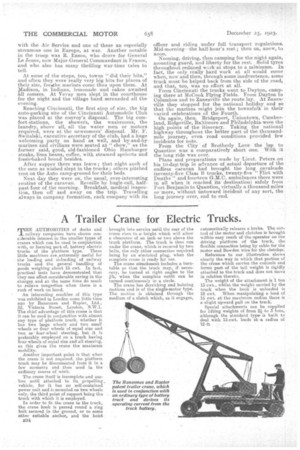A Trailer Crane for Electric Trucks.
Page 16

If you've noticed an error in this article please click here to report it so we can fix it.
THE AUTHORITIES of docks and railway companies have shown cons:derable interest in the smaller types of cranes which can be used in conjunction with, or forming part of, battery electric trucks of the platform type. These little machines are ,extremely useful for the loading and unloading of railway trucks and the general handling of goods weighing about 15 ci,vt. In fact, practical tests have demonstrated that they can effect considerable saving in the charges and at the same time do much to relieve congestion when them is a rush of work on hand.
An interesting machine of this type was exhibited in London some little time ago by Ransomes and Rapier, Ltd., 32, Victoria Street; London, S.W.1. The thief advantage of this crane is that it can be used in conjunction with almost any type of platform truck, whether it has two large wheels and two small -wheels or four wheels of equal size and two or ' four-wheel steering, but it is preferably employed on a truck having four wheels of equal size and all steering, as this gives the crane the maximum mobility.
Another important point is that when the crane is not required, the platform truck may be disconnected from it in a few moments and then used in the ordinary course of work.
The crane itself is incomplete and useless until attached to its propelling_ vehicle, for it has no self-contained power unit and is mounted on two wheels only, the third point of support being the truck with which it is employed.
In order to fit the crane to the truck, the crane hook is passed round a ring bolt secured in the ground, or to some other suitable anchor, and the hoist
534 brought into service until the rear of the crane rises to a-height which will allow a clearance of an inch or two above the truck platform. The truck is then run under the crane, which is secured by two bolts, the only other connection required being by an electrical plug, when the complete crane is ready for use.
The crane attachment includes a turntable so that. the truck may, if necessary, be turned at right angles to the jib, when the complete outfit can be turned continuously in a circle.
The crane has derricking and hoisting motions and is of the single-motor type. The motion is obtained through the medium of a clutch which, as it engages,
automatically releases a brake. The control of the motor and clutches is brought within easy reach of the operator on the driving platform of the truck, the flexible connection being by cable for the motor and Bowden wire for the clutches.
Reference to our illustration shows clearly the way in which that portion of the crane which carries the controls and forms part of the tail weight is rigidly attached to the truck and does not move in relation thereto.
The weight of the attachment is 1 ton 15 cist., whilst the weight carried by the truck when the hook is unloaded is 18 cwt. When manipulating a load of 15 cwt. at the maximum :radius there is a slight upward pull on the truck.
Special attachments can be supplied for lifting weights of from 24to 3 tons, although the standard typeis built to deal with 15-cwt. loads at-a radius of 1.2 ft




























